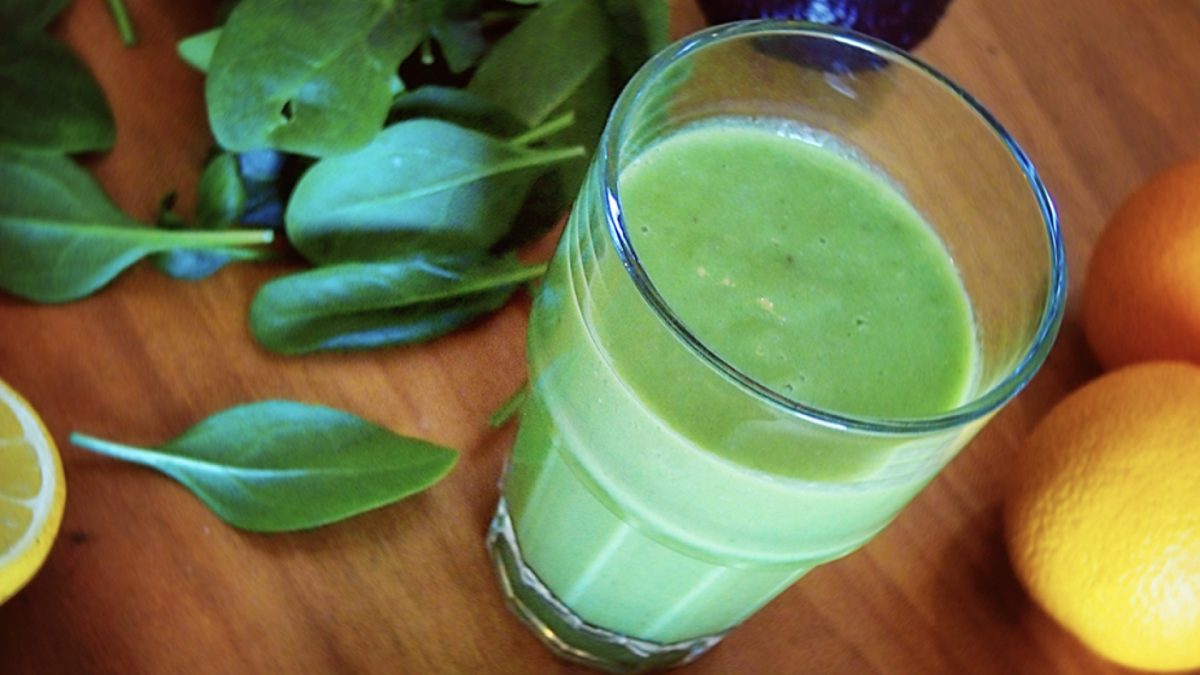Unhealthy lifestyle behaviors associated with an increased risk of premature death include smoking, excessive alcohol drinking, and not eating enough greens. The best way to get your greens is in whichever way you’ll eat the most of them, and one way to sneak extra greens into your daily diet is with whole-food smoothies, “a potent blend of good nutrition” in a quick, portable, delicious form.
The Mayo Clinic offers a basic green smoothie recipe, combining the healthiest of fruits and the healthiest of vegetables, berries and dark green leafies, respectively. It calls for 2 ounces of baby spinach, which is about a cup and a half. Consider adding in some curly parsley, another mild beginner green to start with. Surprisingly, the sweetness of the fruit masks any bitterness from the greens such that the pickiest of children love these smoothies, as do adults who otherwise would not consume dark green leafy vegetables—or even fruit—for breakfast. Indeed, the average teen may only get about 1/20th of a serving of fruit otherwise—and Froot Loops don’t count.
Offering smoothies can have a dramatic effect on fruit consumption for “students who do not want to take time peeling or chewing fruits.” (Who doesn’t have time to chew a fruit?!) The milkshake-y texture of smoothies may not only boost the quantity of fruit and vegetable consumption, but also the quality.
Carotenoid phytonutrients, like beta-carotene and lycopene, can exist as microscopic crystals trapped inside the cell walls of fruits and vegetables. They’re only released when the cells are disrupted, which is why we have to chew really well. We either have to chew better or choose plants that are easier to chew. For example, while tomatoes have more beta-carotene than watermelon does, watermelon’s beta-carotene is more bioaccessible because its cell walls are wimpy compared with the smaller and tougher cell walls of other fruits and vegetables. To maximize nutrient release, food particle size would ideally be reduced to smaller than the width of the individual plant cells, but you can’t do that with chewing. Most vegetable particles end up greater than two millimeters when you chew them, whereas if we broke open all the cells, we could release much more nutrition, as you can see in my video, Are Green Smoothies Good for You?. The particle size distribution from chewing is about what you’d get blending in a food processor for about five seconds or one of those high-speed blenders for maybe half a second. Just 40 seconds in a blender can break down spinach to a subcellular level.
Why does that matter? Let’s look at folate, the B vitamin in greens that is especially important for women of child-bearing age. Feed people a cup of spinach a day for three weeks and their folate goes up compared to control. What happens if you eat finely chopped spinach instead of whole leaves? You end up with more than twice as much in your bloodstream and the same absorption-boosting effect with lutein, the green nutrient so important for our eyesight.
It’s not what you eat—it’s what you absorb.
The boost for lutein was only 14%; so, a few extra bites of the whole leafy greens would have given you just as much. Some other nutrients, such as vitamin C, aren’t affected by pre-chopping at all. This is also less of an issue with cooked vegetables. If you boil carrots for three minutes, regular chewing can release about ten times more beta-carotene bioaccessibility than eating them raw, but not as much as blended. Intense cooking, like boiling for 25 minutes, damages the cell walls so even gulping down large particles can result in significant absorption. But, blending may double carotenoid availability, explaining why we may be able to absorb three times the alpha- and beta-carotene from pureed cooked carrots compared to mashed cooked carrots. So, blending vegetables—raw or cooked—into soups, sauces, or smoothies can maximize nutrient absorption. Whether you went to the store and bought it, or toiled in your garden to grow it, you might as well take full advantage of it.
Check out my other videos that touch on smoothies:
- Are Green Smoothies Bad for You?
- The Downside of Green Smoothies
- A Better Breakfast
- Juicing Removes More Than Just Fiber
For other tips on getting children of all ages to eat healthier, see Tricks to Get Kids to Eat Healthier at Home and Tricks to Get Adults to Eat Healthier.
Finally, learn more about the effect of cooking on nutrient loss and absorption from these videos: Best Cooking Method, Raw Food Nutrient Absorption, and Sometimes the Enzyme Myth Is True.
In health,
Michael Greger, M.D.
PS: If you haven’t yet, you can subscribe to my free videos here and watch my live, year-in-review presentations:
- 2012: Uprooting the Leading Causes of Death
- 2013: More Than an Apple a Day
- 2014: From Table to Able: Combating Disabling Diseases with Food
- 2015: Food as Medicine: Preventing and Treating the Most Dreaded Diseases with Diet
- 2016: How Not To Die: The Role of Diet in Preventing, Arresting, and Reversing Our Top 15 Killers
